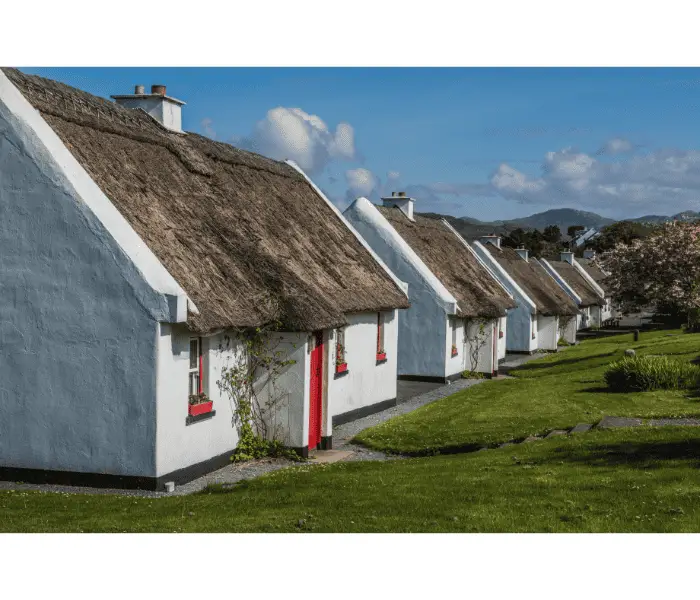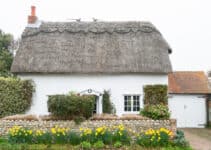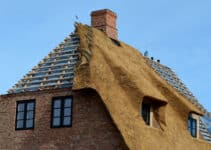A thatched cottage with a red door is an image that evokes Ireland’s rural past. We know, of course, that Ireland’s past wasn’t always idyllic, but images of a family standing proudly outside their thatched cottage seem to gloss over the hardships they faced.
But are there still thatched roofs in Ireland? Yes! Despite the migration of millions of Irish people during the famines of the 1800s and those that have left their homes after that time, many of the thatched roofs still remain.
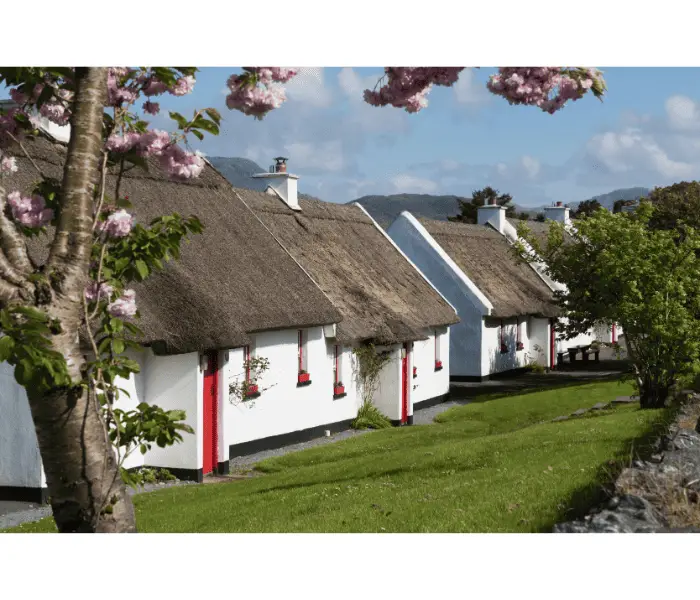
Are Thatched Roofs In Ireland Different From Britain?
Perhaps you were wondering if Irish thatched roofs were different to those you might find in the UK. The answer is, largely, no.
They bear a resemblance to thatched roofs almost anywhere in the rest of the British Isles as thatching techniques are very similar although the overhang is usually shorter.
The only real difference might be in the cottage dimensions themselves. In Ireland, cottages tend to be long and low, usually single-story.
The architecture is similar to cottages found in rural Scotland. But in England and Wales you are just as likely to find a thatched cottage has two stories as one.
Over time, these simple Irish dwellings may have been extended to form an L-shape or ‘wings’. But even when this modification has occurred, they usually remain on one floor.
But their thatching remained relatively uniform.
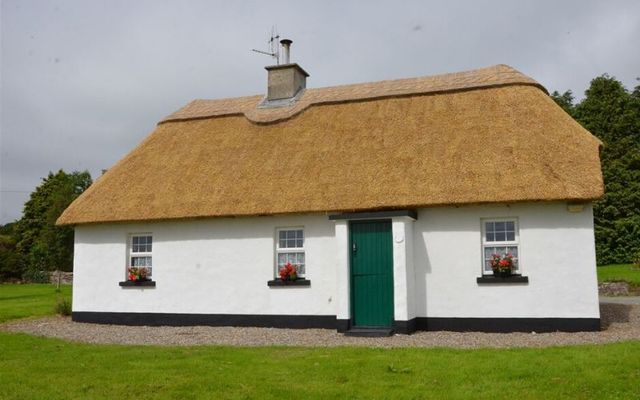
How Many Thatched Roofs are there in Ireland?
In the early 1900s, Ireland boasted tens of thousands of thatched cottages scattered across the country. Obviously, the majority were in rural areas but a few could be found in towns that were once villages.
Now, Ireland can only claim just over 2,000 thatched roofs. And while this loss of Irish rural heritage may seem sad, there are few rural homeowners that can afford the cost of maintaining their thatch or, indeed, find a registered Irish thatcher to complete the work.
As of 2021, the Irish thatching trade seems to be in a mini-crisis. Not because there is a shortage of work but because there are so few appropriately trained thatchers on Irish soil.
Philip Doran who is a registered thatcher living in County Laois claims that he is the only thatcher in three counties. And he also says he can, ‘count on my fingers the number of working thatchers left in Ireland.’
The Decline of Thatched Roofs in Ireland
As beautiful as many of Ireland’s thatched cottages are, there are just as many that are left unoccupied or are in a state of disrepair.
Especially as the thatch roofs of these rural dwellings would have been maintained by the owners themselves using local material to patch the thatch.
Many rural cottages have elderly residents who are unable to repair the thatch or pay for rethatching, and the decline does not seem to be halting.
For those of us who love heritage buildings, especially those with thatch, is a sad state of affairs. But it’s also an indication of the decline of rural crafts and professions in general. Not to mention the increasing costs associated with having a thatched roof.
But don’t get too downhearted, there are still plenty of thatched roofs to spot if you’re touring the Irish countryside. And there’s even an Irish village that has quite a few to look at.
What Town in Ireland has thatched roofs?
Adare, County Limerick, is famous for its main central street which has a row of thatched-roof cottages.
But while Adare is usually called a village by visitors and residents alike, it is designated as a heritage ‘town’ by the Irish Government because it forms a part of the larger Dunraven Estate which also falls under the heritage designation.
The village can be found south-west of the city of Limerick and is a popular tourist destination. Visitors flock to Adare’s ‘cottage core’ to witness a street that time seems to have forgotten.
Objectively, the row of thatched cottages perfectly captures the authenticity of traditional rural Irish dwellings. But it’s not quite that simple.
When and Why Was Adare Built?
The village’s history is a little less organic than most rural villages and the thatched cottages are a blend of Irish and British design.
This is because the owner of the nearby Dunraven Estate was the Earl of Dunraven, whose wife, Caroline Wyndham-Quin, spearheaded the building of Welsh and English-style thatched cottages in Adare during the 1830s.
The cottages were built by and for the workers from the Dunraven Estate which was intended to give them a better standard of living.
And, during the Great Famine of 1948, Caroline provided additional employment to famine struck workers by engaging them in the construction of Adare Manor.
Dunraven Estate and Adare’s thatched cottages are undoubtedly eye-catching. But the heritage site is not without its critics.
Some believe that preserving the village in this way makes Adare a little bit like a Disneyland version of Ireland’s past. They also claim that literature about the village tends to gloss over the real hardships of rural life.
What is the History of Thatched Roofs in Ireland?
Like almost everywhere else, thatched roofs in Ireland go back millennia. The first thatched roofs in Ireland belonged on huts.
These huts were round houses that were initially made of wattle and daub and then made out of stone – although materials varied according to region.
Like most rural folk, the dwelling owners (with friends and family) would have been responsible for the construction of their homes and almost certainly for the thatching.
The thatch, like the cottage construction material, would have been locally sourced. If you lived near a river you might find reeds which are considered the best thatching materials. Or, wheat stalks if you lived in a farmed area without a reed bad.
The evolution from thatched hut to thatched cottage was a long one. But the picture-postcard cottages that you might see on your travels around the Emerald Isle are most likely built in the 1700s or the 1800s. And it would also have been around this time when the craft of thatching may have taken on full-time potential.
Thatching would have been a superior skill needed for larger cottages than for smaller huts and so a new industry was born!
Ireland is proud of its heritage and no less of its thatched-roof cottages. While the number may be reducing around the country, those that remain are a source of joy to their owners and to the millions of tourists that are drawn to them every year.
